DEFINITIONS AND OPERATIONAL CHARACTERISTICS OF ROAD AND TRAIL USERS
This section provides a working definition of each user group. The basic characteristics of the vehicles or devices used by each group are described, as are the users' varying abilities. Earlier studies of inline skates, scooters, strollers, electric bicycles, adult tricycles, recumbents, tandems, bicycle trailers, golf carts, and assistive technologies are referenced and are listed in the appropriate sections. Other sources are included, such as articles in academic journals, conference proceedings, manufacturers' Web sites, public health and advocacy Web sites, and retailer Web sites.
Inline Skates
Inline skates, like their predecessors, quad-wheel skates, are used extensively throughout the United States for recreational and transportation purposes by people of all ages and athletic abilities (figure 1). They typically have three to five wheels of about 75 to 100 millimeters (mm) (3 to 4 inches) (Unless otherwise noted, all photos are by Bruce W. Landis.) with a single frame to a shoe or boot that is usually fairly stiff, providing good support and control. Unlike roller skates with two sets of wheels side by side (quad skates), inline skates can be used in much the same way as ice skates, resulting in more efficiency and higher speeds. Few quad skates are now in use, so this study focused on inline skates.
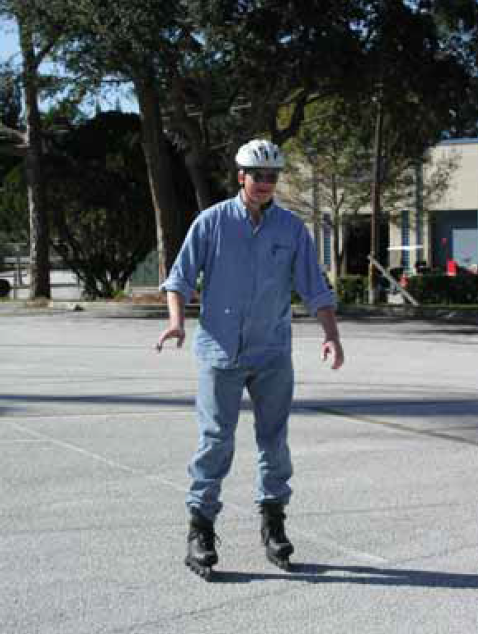
Figure 1. An inline skater.
(Unless otherwise noted, all photos are by Bruce W. Landis.)
Inline roller skates were first developed in the 18th century, preceding the quad skate design invented in the late 19th century; however, the technology then available, quad skates offered more control and became the standard for many years. In the early 1980s, inline skates were reborn based on modern technology, ultimately resulting in the remarkable increase in usage experienced in the 1990s.(3,4,5) With smooth street surfaces and the introduction of polyurethane wheels, inline skates have become very useful devices for transportation and recreation on public ways.
Inline skating grew rapidly as a sport through the 1990s, stabilizing in recent years with about 29 million users in the United States.(6) This represents primarily recreational users, but the growth in recreational users translates to growth in transportation use; many skaters soon realize the transportation potential of skates. As a result, skating is emerging as a mode of transportation.(7)
3. National Museum of Roller Skating (NMRS), various Web pages. www.rollerskatingmuseum.com. Accessed April 23, 2002.
4. Mathis, K. Inline Skating Still a Growth Leader. May 8, 1998. www.iisa.org/releases/980508-growth.htm. Accessed March 18, 2000.
5. International Inline Skating Association (IISA), "Inline Skating Facts & Figures." www.iisa.org/numbers/index.htm. Accessed March 18, 2000.
6. American Sports Data, Inc. Press Release, April 1, 2001. www.americansportsdata.com. Accessed April 23, 2002.
7. Osberg, J. S., S. Faul, J. Poole, and J. McHenry. Skating: An Emerging Mode of Transportation. Presented at the 79th Annual Meeting of the Transportation Research Board, Washington, DC, January 10-14, 2000.
Skating Skill and Performance
According to recent research, differences in skaters' skill levels can result in significant differences in operational characteristics. For example, novice skaters typically travel more slowly and have a narrower sweep width than advanced skaters.(8) Skaters choose among several different techniques to stop, often based loosely on their general skating ability. The more basic stopping techniques used by novice skaters require longer time and distance to stop from a given speed. Novice skaters have difficulty making sharp turns and stopping quickly, especially on downhill grades.(9) Skaters with more practice and experience typically travel at higher speed, which corresponds with a wider sweep width.(8) These skaters also have much more maneuverability and control. Some techniques employed by advanced skaters can stop them in a very short distance when necessary.
8. Birriel, E., J.C. Pernia, J.J. Lu, and T.A. Petritsch. The Operational Characteristics of Inline Skaters. University of South Florida, Tampa, FL, January 2001.
9. Osberg, J.S., and S.C. Stiles. Safety Behavior of In-line Skaters. Injury Prevention, Vol. 6, No. 3, 2000, pp. 229-231.
Skateboards
Skateboards have a platform attached to sets of small wheels (usually four), but do not have steering handles. Each set of wheels is attached to the platform with a pivoting "truck," which allows the board to turn when the user leans his or her body and/or feet. Skateboards are available in many different shapes and sizes, and with different wheel diameters. The variation in sizes results in potential differences in speed, turning radius, and other operational characteristics.
Traditional skateboards are under 84 cm (33 inches) long, but "long boards" over 89 cm (35 inches) are used for "cruising." Skateboard decks are normally about 19 cm to 21 cm (7.5 to 8.25 inches) wide. Skateboard wheels are normally 52 mm to 60 mm (2.05 to 2.36 inches) in diameter. Larger wheels are often used on long boards.
Motorized skateboards are also available, but have diminished in popularity in part due to the increased popularity of motorized kick scooters as described below. In addition, motorized skateboards are specifically prohibited from the public right-of-way in many jurisdictions.
Kick Scooters
This group includes users of kick scooters that typically have two inline wheels connected by a platform that is large enough for a user to stand on with one or two feet. Steering handles are attached to the platform, allowing users an additional point of contact with the board to steer the device and maintain an upright position. This user group includes two subgroups: foot powered kick scooters, and similar standup devices with attached motors. Sit-down 3- or 4-wheel assistive powered scooters used by individuals with disabilities are not included in this user group, but are described later in this document. This user group also does not include the sit-down vehicles also referred to as scooters that are in effect small motorcycles (e.g., Vespastm) intended primarily for roadway use.
Nonmotorized Kick Scooters
The most common nonmotorized kick scooters have approximately 100-mm (4-inch) diameter polyurethane wheels like those on inline skates (figure 2). The platform is usually relatively short and too narrow (100 mm (4 inches)) for two feet side by side. Larger nonmotorized scooters with bigger platforms and 150-mm to 300-mm (6- to 12-inch) wheels with polyurethane or rubber tires are also available. These larger scooters are currently less prevalent, but because they provide more utility due to improved efficiency, several manufacturers are developing and promoting larger models.
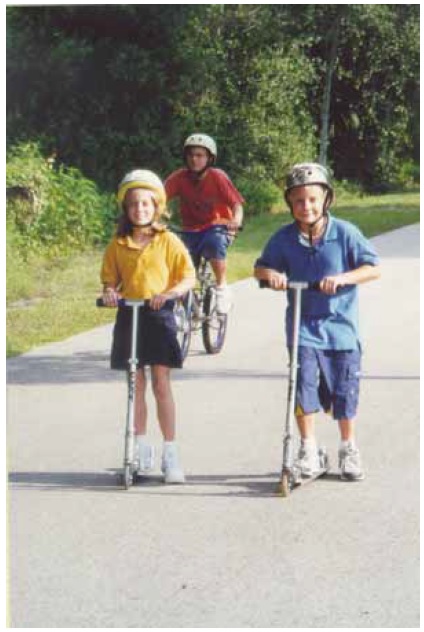
Figure 2. Nonmotorized kick scooters.
Two braking systems are common. Smaller, less expensive scooters have an articulated fender over the rear wheel that can be stepped on to create friction with the wheel. Larger models have a hand brake much like the brakes used on bicycles. A few inexpensive models have no brakes; users simply step on the rear wheel with their shoes or skid their feet on the ground.
Nonmotorized kick scooter use in the United States has increased phenomenally in the past several years. Although very few were sold in 1999, it was estimated that approximately 5 million scooters were sold in the United States in 2000.(10) As expected, scooter crashes have increased significantly as well. The U. S. Consumer Product Safety Commission (CPSC) reported a 13-fold increase in emergency-room-treated scooter injuries between the first and second half of 2000, from 2,820 to 37,750.(11)
Operational characteristics for nonmotorized scooters depend on many factors, including the abilities of the user and the design of the scooter. For example, a nonmotorized scooter with large aluminum wheels has lower rolling resistance than a scooter with small inline skate-type wheels, potentially resulting in faster acceleration rates and higher speeds. It is likely that the different braking systems result in different stopping distances and deceleration rates. Scooters likely have varying maneuverability, as well.
10. Rutherford, Jr. G. W. and R. Ingle. Unpowered Scooter-Related Injuries-United States, 1998-2000. CDC MMWR Weekly, Vol. 49, No. 49, December 15, 2000, pp. 1108-1110. www.cdc.gov/mmwr/preview/mmwrhtml/mm4949a2.htm. Accessed August 10, 2001.
11. Consumer Product Safety Commission. Motorized scooter use increases and injuries climb. Press release, August 22, 2001. www.cpsc.gov/CPSCPUB/PREREL/prhtml01/01222.html
Motorized Kick Scooters
Motorized kick scooters are usually larger than nonmotorized ones. Because the user does not normally need to push, these scooters often have a platform wide enough for two adult feet side by side. Motorized scooters can be either gasoline or electric powered. There are many different manufactures and styles of scooters with different characteristics. Due in part to legislation in some States, most scooters are governed to speeds below 32 km/h (20 mi/h). However, many owners of powered scooters customize their scooters, often removing or modifying the governors. Motorized scooters usually have hand brakes and often have larger, pneumatic rubber tires; and some have pedestal seats.
Baby Strollers
This user group includes a variety of wheeled devices pushed by adults to transport babies or small children. Some stroller models can accommodate up to three children; a few models for four or more are also available on a limited basis. Stroller size varies greatly depending on the number of children to be carried and the type of stroller. The operational characteristics for all types of strollers depend on the wheel size, stroller geometry, and the physical ability of the adult who is pushing the stroller. On most strollers, the babies sit in a partially prone position facing away from the person pushing the device. Larger strollers (often called "baby carriages") where babies lie totally prone are relatively rare in the public right-of-way.
Limited research has been conducted on the use of strollers on public streets and shared use paths. However, two sources discuss stroller safety; one of the main stroller safety concerns is lateral overturning.(12,13)
12. Jana, L. Practical Stroller Safety Tips. www.drspock.com/article/0,1510,5222,00.html. Accessed August 14, 2001.
13. Juvenile Products Manufacturers Association. Carriage and Stroller Safety Remains Important. www.jpma.org/public/pr-043099.html. Accessed August 14, 2001.
Conventional Strollers
These devices typically have four wheels or four pairs of wheels; the wheels are generally small, about 150 mm (6 inches) in diameter. Strollers for one or two children are common, but strollers that carry three or four children are available as well. The small pivoting front wheels on these strollers make them fairly easy to maneuver, but limit their use on unpaved surfaces or rough pavement. These strollers are fairly difficult to maneuver over curbs, so the installation of curb ramps in the public right of way is valuable to these users. Umbrella strollers are foldable, lightweight versions of conventional strollers.
Jogging Strollers
In recent years, large-wheeled jogging strollers have become increasingly popular, especially for longer distance use on paths and roads (figure 3). These strollers usually have spoked wheels of about 300 to 500 mm (12 to 20 inches) diameter with pneumatic rubber tires allowing use at higher speeds and over more varied terrain. Jogging strollers that carry one or two children typically have three wheels, two in the back and one in the front; those for three children are more rare and typically have narrowly spaced front wheels and two rear wheels with wider spacing. The wheels of jogging strollers do not pivot, so steering is accomplished by unweighting the front wheel or wheels and rotating the stroller on the rear axle. Some jogging strollers have hand brakes similar to bicycle brakes, improving stopping capabilities at higher speeds.
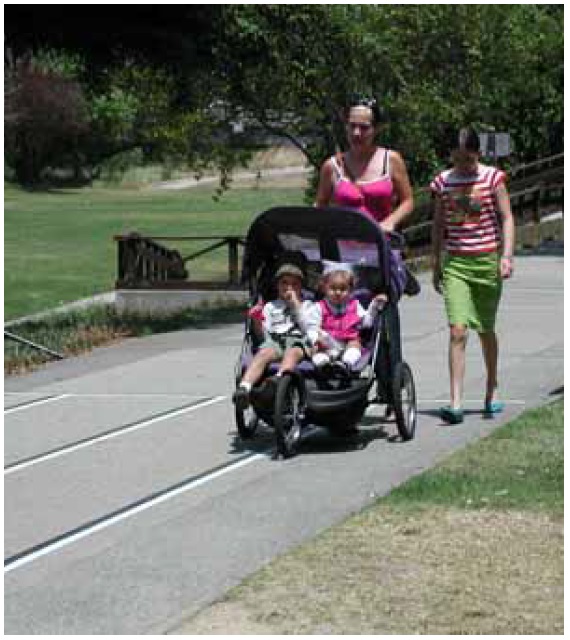
Figure 3. Jogging stroller for two.
Electric Bicycles
Electric bicycles are similar in geometry to human-powered bikes but have a motor that provides pedal assistance and allows riders to accelerate, climb hills, and overcome wind resistance more easily than manually powered bikes. Depending on the rider's weight, the terrain, and wind conditions, the average rider who travels a distance of 16 km (10 miles) at 16 km/hr (10 mi/h) under manual power can travel at 24 to 32 km/h (15 to 20 mi/h) with the same effort when assisted by electric power.(14) Electric bicycles can be obtained as stand-alone products or by adding an electric assist unit to an existing bicycle.
Many States have addressed electric bicycles through legislation. Often the legislation allows electric assisted bikes on bike lanes and shared use paths. For example, an electric bicycle is legally a "bicycle" in California, according to California Vehicle Code CVC 406(b).(14) In Florida, electric bicycles that travel under 32 km/h (20 mi/h) are considered "bicycles."(15)
Because many State statutes limit speeds to 32 km/h (20 mi/h), manufacturers generally design and govern their electric bicycles to match this speed. This speed is not much different from that of a normal bicycle, so many operational characteristics are anticipated to be similar to those for bicycles.
It should be noted that there are also recumbent bicycles, tandem bicycles, and adult tricycles with electric-assisted power. Because these vehicles are relatively rare, they will probably not be evaluated independently, but some operational characteristics will likely be similar to their nonelectric equivalents.
14. Electric-Bikes.com. www.electric-bikes.com/others.htm. Accessed August 10, 2001.
15. State of Florida. The 2000 Florida Statutes. Title XXIII, Section 316.1995. Online Sunshine, www.leg.state.fl.us/Statutes/index.cfm?App_mode=Display_Index&Title_Request=IV. Accessed August 14, 2001.
Tandem Bicycles
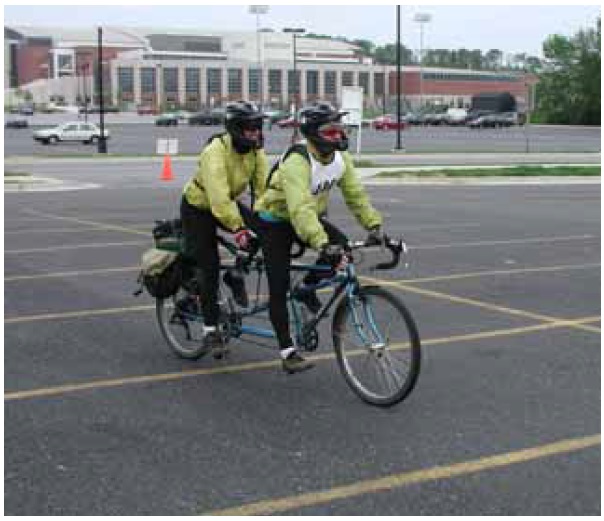
Figure 4. Tandem bicycle.
Tandem bicycles (often called tandems) have positions for two cyclists; typically, the front rider (the "captain") is responsible for steering, balance, shifting, braking, and pedaling, while the back rider (the "stoker") adds pedaling power (figure 4). Due to the significant increase in pedaling energy without much additional wind resistance, tandems allow riders to travel faster and farther with the same effort. The greater mass of a tandem means that tandem bicycles are generally slower traveling uphill and faster traveling downhill than single bikes. Tandem bicycles are typically equipped with multiple gears, including higher gears to accommodate the additional power.
Most tandem bicycles are similar to upright single bikes where riders sit on a small saddle and reach forward to handlebars that are typically at or slightly above or below the seat height. Tandem bicycles are also available in recumbent versions. See below for a more detailed description of recumbent bicycles.
Recumbent Bicycles
Recumbent bicycles, often simply called recumbents (or bents), are bicycles that allow riders to sit in a broad seat, usually with a backrest, potentially reducing neck and wrist pain. Recumbent handlebars are either in front of the user's arms hang naturally.(16) The pedals on recumbent bicycles are usually well forward of the seat (figure 5).
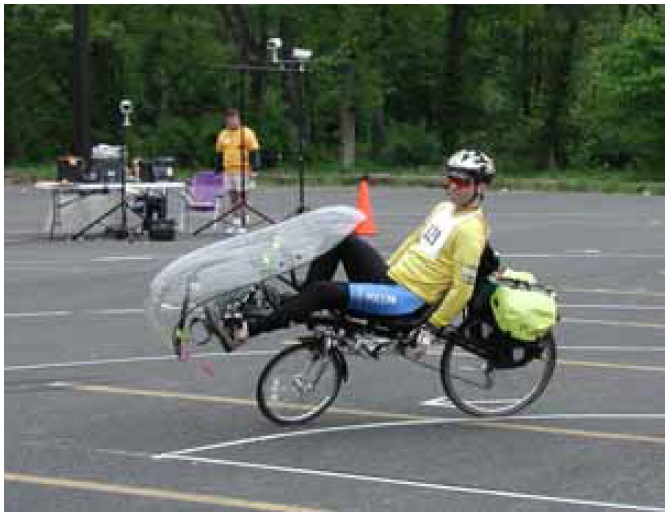
Figure 5. Recumbent bicycle.
Two-wheeled recumbents can be difficult to learn to balance, especially those with under-seat steering. As a result of the seated position, dismounting is more difficult on a recumbent as well. With pedals in front of the seat, riders cannot take advantage of their weight as on a standard bike. This typically results in slower acceleration from stops and the need for lower gears on hills, resulting in slower climbing speeds. The reduced wind resistance of recumbent bicycles provides for increased efficiency, resulting in higher speeds. Recumbents are generally longer and wider than upright bicycles, but they are available in many different shapes and sizes so length and operating width vary greatly. Their low profile results in decreased visibility by other road users, so many recumbent cyclists attach tall flags to increase their visibility.
16. Recumbents.com. www.recumbents.com. Accessed April 24, 2002.
Recumbent Tricycles
Some recumbents are tricycles, most often with two wheels in the front (sometimes two in the rear). These vehicles are wider and more stable at low speed than two-wheeled recumbent bicycles. However, when turning at higher speeds, these vehicles can be unstable. Manufacturers strive to maintain a low center of gravity and use high-tech steering mechanisms to overcome turning instability problems. Simpler, less efficient tricycles used by riders who have mobility impairments are discussed later in this report.
Tandem Recumbent Bicycles
Recumbent bicycles are also available in tandem versions. Tandem recumbent bicycles have the potential for fairly high cruising speeds due to the lower wind resistance of a recumbent combined with the additional energy output of a tandem. These vehicles are uncommon.
Bicycle Trailers
Bicycle trailers are often used to carry children and to transport cargo. Trailers add to the total vehicle length and weight, which may decrease speed and maneuverability, while increasing turning radius and stopping distance. Trailers come in many different shapes and sizes, and are generally low to the ground, so other users may not see the additional length added to a bicycle. Trailer visibility is of increased importance when carrying children. Safety recommendations in several sources include installing a highflying fluorescent warning flag to increase visibility, allowing plenty of stopping distance, and using caution when maneuvering through tight areas.(17,18)
17. Stamford, B. Child Carriers: Tips for Runners, Bikers, and Hikers. The Physician and Sports Medicine, Vol. 26, No. 11, November 1998. www.physsportsmed.com/issues/1998/11nov/carriers.htm. Accessed August 14, 2001.
18. WIKE Ultralights. Bicycle Trailer Safety. www.wicycle.com/safety.htm. Accessed August 14, 2001.
Trailers with Two Wheels
Many two-wheeled trailers are available for carrying children and cargo. Width and length vary, although the majority are relatively small trailers used for carrying children. A single design "vehicle" using the specifications of one of these trailers was used for evaluation. These trailers do not track behind the bicycle well, resulting in reduced maneuverability, especially at higher speeds.
Trailers with Single Wheel
A few single-wheeled trailers are available. These tend to be relatively compact and follow the bicycle very well. Maneuverability of the bicycle is not generally affected, but stopping distances are naturally increased due to the excess weight. These trailers are less common and they have much more maneuverability than two-wheeled trailers.
Trailer Bicycles
Several models of trailer bicycles or "railercycles" are available and used by many families on roads and shared use paths. These devices consist of a single-wheel "half bike" in a child's size that can be attached to the back of a standard adult bicycle (or a tandem). These devices are relatively rare.
Segway Human Transporter
The Segway Human Transporter (HT) is a self-balancing, electric-powered transportation device (figure 6). Its footprint is not much larger than the human body's and has a handlebar and platform similar to a scooter, but with two wheels side by side. The Segway uses gyroscopes and tilt sensors to monitor the body's movements and balance the device on the single axle. When a person leans forward, the Segway HT moves forward; leaning backward causes it to move back. The Segway has no brakes; to stop the device, users simply straighten up from their leaning position. Turning is accomplished with a twisting motion on the handlebar. Because both wheels are on one axle, it can turn in place with no turning radius.(19)
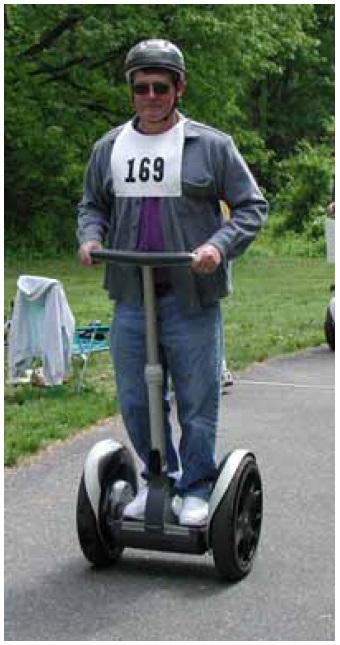
Figure 6. A Segway user.
The Segway HT easily can be governed to travel at various speeds up to a maximum of 12.5 mi/h (20 km/h).(19) The manufacturer has been actively pursuing legislation throughout the United States to allow the Segway on sidewalks and paths. In some cases, requirements for different speeds on roads and sidewalks are being considered.
19. Segway, LLC home page. www.segway.com. Accessed May 2, 2002.
Manual Wheelchairs
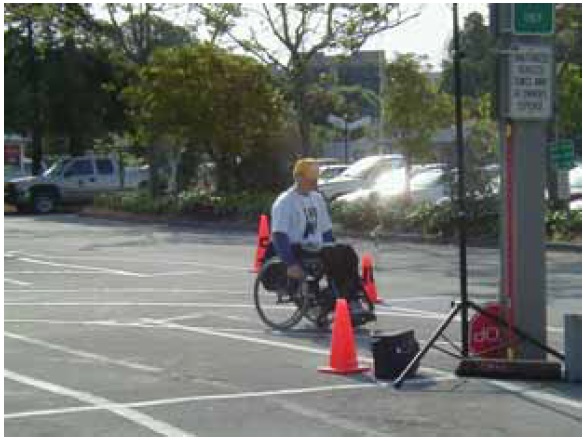
(Photo by Peter Axelson.)
Figure 7. Manual wheelchair.
The manual wheelchair user group are individuals who use wheelchairs that are propelled by their own muscular strength and endurance (figures 7 and 8). Manual wheelchairs have a seat between two rear wheels usually about 600 mm (24 inches) in diameter. The 75-mm to 200- mm (3- to 8-inch) front wheels swivel to allow for easy steering. Users can propel themselves using push rims attached to the rear wheels. Braking is accomplished by resisting wheel movement with the hands or arms. Alternatively, another individual can control the wheelchair using handles attached to the back of the chair.
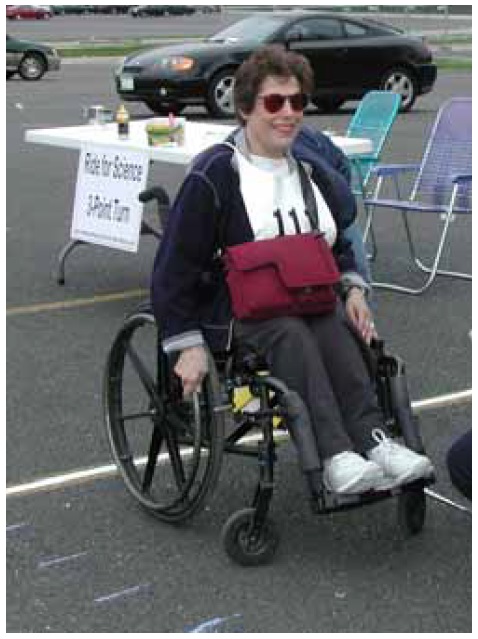
Figure 8. Another manual wheelchair.
There are two general types of manual wheelchair: standard and lightweight; their performance characteristics are significantly different. Standard wheelchairs are typically used by individuals living in institutions, those who lack the financial resources for the purchase of a lightweight model, or those who simply prefer them. Lightweight wheelchairs are often referred to as "sports chairs" or "ultralights." Their design is based on the types of wheelchairs developed by athletes with disabilities over the past 20 years. They usually feature a lighter weight frame, smaller footrests, smaller front caster wheels, lower back support only, and no arm rests in comparison to the standard models. They are also much more expensive than a standard manual wheelchair.
Power-assist wheels are devices that can be attached to either a standard or lightweight manual wheelchair. They provide propulsion via an electric motor to assist individuals with more limited arm strength who wish to travel over longer distances. A power unit with pneumatic tires and a steering tiller can also be attached to the front of a manual chair.
There are several different categories of users of manual wheelchairs ranging from those with full upper body function to those with no independent mobility. Manual wheelchair users with limited or no independent mobility are generally pushed by another person, and may be trail users too.
Power Wheelchairs
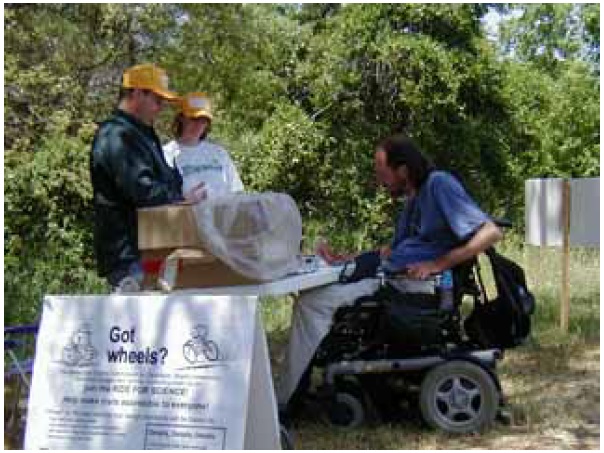
(Photo by Peter Axelson.)
Figure 9. Power wheelchair.
Power wheelchairs utilize battery power to move the wheelchair (figure 9). Power wheelchairs are expensive relative to manual wheelchairs and typically weigh up to 115 kilograms (kg) (250 pounds). They often cannot be folded or disassembled for transport, so a ramp or lift-equipped van is required. The weight and bulk of a power wheelchair severely limits the size of obstacles-usually less than 50 mm (2 inches) in height-that can be negotiated without a ramp or bevel. Braking is usually passive; it occurs with deceleration when the power is turned off. Power wheelchairs are available in many different shapes and sizes. Many different wheel sizes are available as well.
Individuals who use power wheelchairs typically have conditions that significantly limit their upper and lower body movement, strength, coordination, or endurance. Various control units are available that enable individuals to control the movement of their power wheelchair with very limited independent movements (e.g., a puff of breath).
Assistive Powered Scooters
Assistive powered scooters are three- or four-wheel devices designed to provide mobility for individuals with limited endurance for walking or using a manual wheelchair (figure 10). These scooters have a tiller for steering and a comfortable seat, usually with a back and armrests. Standup two-wheel scooters used for recreation and transportation by primarily nondisabled users were described earlier in this report and are not included in this user group.
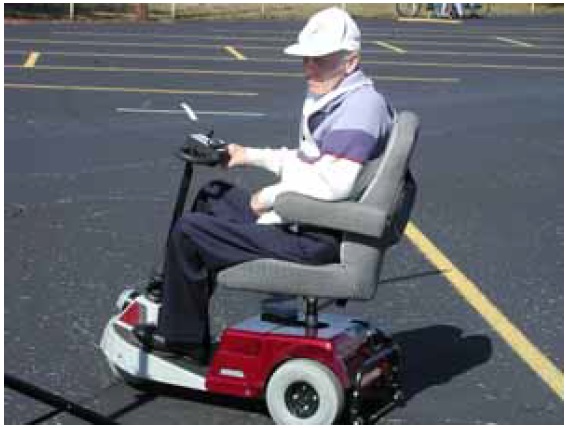
Figure 10. Assistive powered scooter.
These devices typically have a longer wheelbase than a power wheelchair, and are less expensive (costs are approximately comparable to lightweight manual wheelchairs). Power scooters rely on multiple batteries and can weigh up to 90 kg (200 pounds). Braking is provided via disk brakes or by a regenerative braking system utilizing the scooter's motor. Transportation of the scooter requires partially disassembling the scooter (to fit it into a station wagon) or the use of a van or trunk-mounted lift. The tiller steering mechanism requires the user to physically turn the steering handle left and right to turn the vehicle. This requires substantially more strength and range of motion than the typical joystick control provided on powered wheelchairs.
Adult Tricycles
Adult tricycles are primarily used by older adults but may also be used by individuals with disabilities that affect balance or coordination, but who maintain the ability to perform the pedaling and braking motions required for using a tricycle. Adult tricycles generally have a comfortable, upright sitting position and three large wheels (approximately 650 mm (26 inches) in diameter), one in front and two in back. Typically, they do not have multiple gears, which limits their use on hilly or uneven terrain. Individuals who are unable to drive often use tricycles for local transportation, such as a short trip to the store. They can also be used for recreation in a manner similar to bicycles.
Hand Cycles (Stand-Alone)
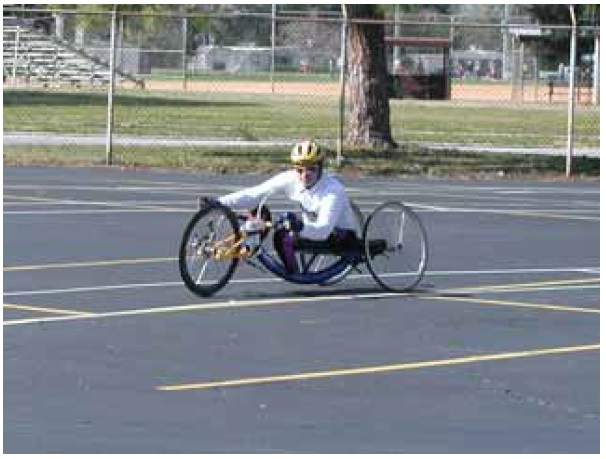
Figure 11. Hand Cycle.
On stand-alone models of hand cycles, the pedaling motion is done with the arms (figures 11 and 12). Hand cycles are available with varying wheel sizes and with the single wheel in either the front or the rear. Hand cycles are also available that are designed with only two large wheels (one front and one back). Additional support, as required, is provided by small caster wheels that are mounted on each side just behind the seat. The caster wheels do not touch the ground unless the rider leans the bicycle to one side or the other.
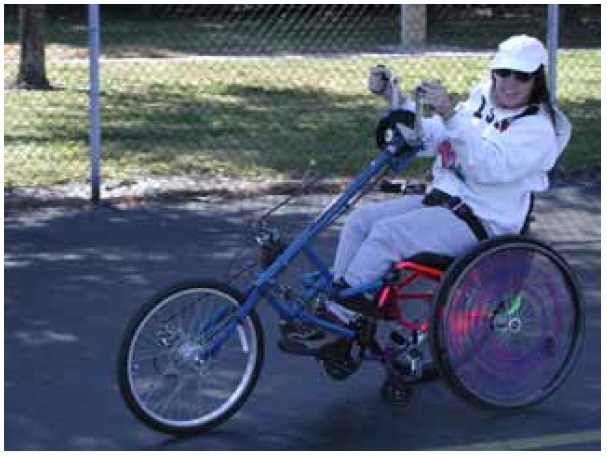
Figure 12. Another hand cycle.
Most stand-alone hand cycles have a relatively long, narrow wheelbase, which decreases the rider's turning ability and increases the risk for capsize with sudden turning movements. Standalone models may offer a wide range of gearing and braking capabilities, depending on the type of use for which they are designed.
Hand Cycle Wheelchair Attachment
Hand cycle attachments that clip onto a manual wheelchair are an example of a propulsion method. Typically, these attachments include a front wheel and arm crank mechanism and incorporate a wide range of gearing options and hand brakes. These attachments offer an arm cycling option to manual wheelchair users but they do not offer the performance of a stand-alone hand cycle model. Hand cycle attachments are typically used for transportation or utilitarian purposes because the user can use the wheelchair in its normal manner when the destination is reached (e.g., cycling to the store). Hand cycle attachments may also be used for recreational purposes, although most experienced cyclists would prefer a stand-alone model.
Racing Wheelchairs
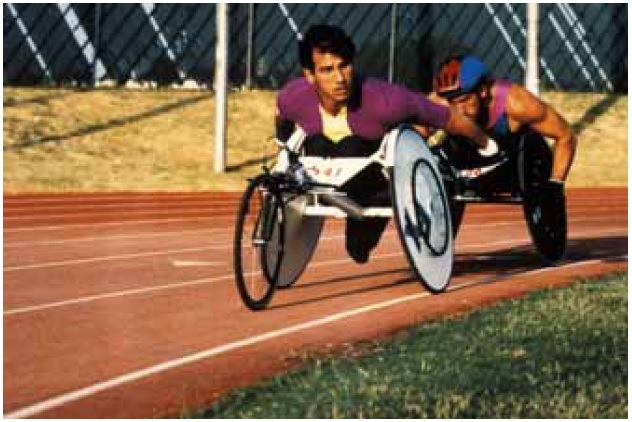
(Photo by Peter Axelson.)
Figure 13. Racing wheelchairs.
Racing wheelchairs are specially modified manual wheelchairs that are designed to maximize their performance in specific activities. They are typically used by competitive athletes for training as well as competition and may be used on road or shared use path surfaces (figure 13). Given the amount of training time dedicated to a particular activity, individuals are usually very experienced and skilled in the use of a racing wheelchair.
Road Racing Wheelchairs
Road racing wheelchairs typically have a long wheelbase and fixed (nonsteerable) front wheels. The wheels consist of two large (approximately 700 mm (27.5 inches)) rear wheels with push rims for propulsion and braking. Most chairs also have hand brakes to assist in stopping at high speeds. A steering mechanism compensates for the crown of the road so that the athlete can push equally with both arms. Racers, even during training, will usually be traveling at a relatively high speed, particularly on downhill sections. Typically, a low seating position is preferred to increase stability and decrease resistance. The low seating position also reduces the user's visibility by other road and shared use path users. Road racing wheelchairs are usually finely tuned for balance and use by one specific individual.
Off-Road Racing Wheelchairs
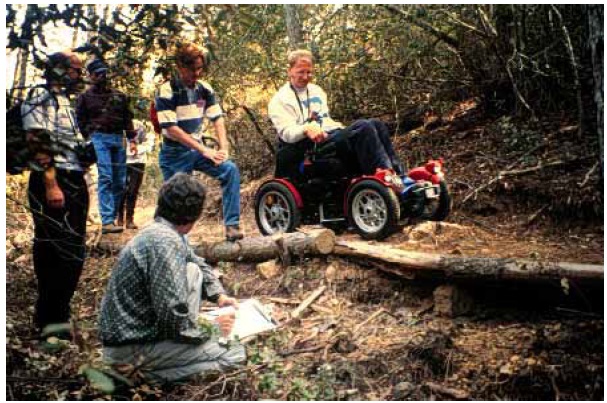
(Photo by Peter Axelson.)
Figure 14. Off-road racing wheelchair.
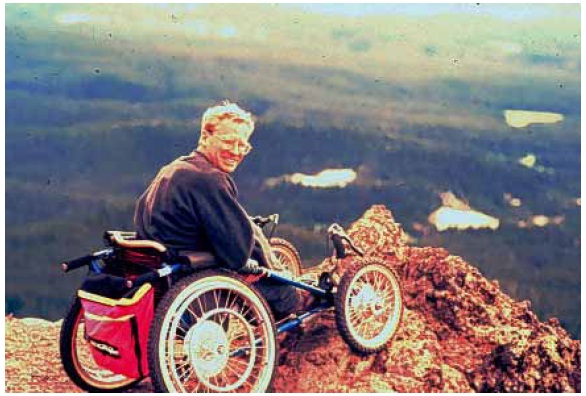
(Photo by Peter Axelson.)
Figure 15. Another off-road racing wheelchair.
Off-road racing wheelchairs typically are designed for recreational use on mountain bike or single-track trails (figures 14 and 15). They typically have all-terrain tires on four wheels with varying sizes from 400 mm to 650 mm (16 inches to 26 inches). They often utilize a more rugged frame, incorporate a suspension system, and provide four-wheel braking systems actuated by hand brake levers. If used, gearing is accomplished through multiple push rims. A long and wide wheelbase with camber on the rear wheels is used to increase stability on a variety of terrains. Although they provide much more stability and control when traveling downhill (e.g., can be driven down a flight of stairs), they can be heavy and cumbersome for movement on level ground or going uphill. These devices are used infrequently on public roads and shared use paths, and were therefore beyond the scope of this study.
Other Road and Shared Use Path Users with Disabilities
A variety of road and shared use path users who do not, at first glance, appear to influence the characteristics of road and path use: (1) individuals with partial or total vision loss (who may not use a white cane or guide animal); (2) individuals with hearing impairments or deafness; (3) individuals with cognitive limitations; and (4) people who use other mobility devices, such as walkers, canes, prostheses, and crutches. While it was beyond the scope of this study to evaluate the characteristics of these groups, it is recommended that the needs of these road and shared use path users be investigated and documented in a future study because their movement characteristics are known to differ from typical or expected patterns.
Individuals with Partial or Total Vision Loss
Individuals with vision loss usually will have independent mobility for use of roads and shared use paths as pedestrians. They often participate with another person (tandem bicycles are particularly popular for individuals with vision loss). Pedestrians with vision loss who use canes will follow edges to travel, while those who use dog guides typically use audible, tactile, and environmental cues in lieu of vision for obstacle detection and gap selection. In addition, their path of travel may be influenced by subtle changes in grade or cross slope that are not readily detected by others, or by overhead and overhanging branches, etc., and things that protrude into their travel paths.
Individuals with Hearing Impairments or Deafness
Individuals with limited hearing rely extensively on visual cues for safe and independent mobility. Unobstructed and well-lit sight lines along a facility and at intersections are needed. They may not respond as expected to the presence of auditory stimuli (e.g., the sound of approaching traffic or cyclists ringing a bell).
Individuals with Cognitive Limitations
For individuals with cognitive limitations, the additional information processing time required to acquire and understand external stimuli may significantly affect their movement and vehicle or device operational characteristics. Stopping times may be increased because of an increase in the time required to understand and interpret the stopping cue. Decisionmaking [sic] and purposeful movement may be compromised in complex situations or rapidly changing environments. The consequences of passing, acceleration, or sudden changes in movement pattern of other road and shared use path users may not be understood or considered.
Other Road and Shared Use Path Users
Although the above summary of user groups is long, other devices and vehicles are occasionally used on roads and streets that have not been listed above. A full evaluation of these devices and vehicles as part of this study was either not possible or unnecessary for one of the following reasons:
-
They are used very infrequently so a reasonable sample size could not be obtained.
-
They are so small or are used at such slow speeds that their operational characteristics are less important because roads, shared use paths, and other public ways will necessarily be designed for the critical operational characteristics of larger and/or faster users.
Although these user groups will not be described in detail, it is important to mention their existence, in the event that their use grows significantly and results in the need for evaluation as part of a future study:
-
Unicycles-Devices with a single wheel, pedals, and a seat.
-
Bicycle rickshaws and pedal carriages-Pedal vehicles with three or four wheels that are intended to carry one or more passengers in addition to the person pedaling the vehicle.
-
Electric toys for children-Small electric devices, usually with four wheels, often designed to emulate full size adult motor vehicles.
-
Child tricycles-Small, three-wheeled pedal devices used by small children.
-
Bicycles with training wheels.
-
"Low rider" bicycles- Bicycles that have been customized for aesthetics to be low to the ground and often longer than standard bicycles.
In addition, mopeds and small motorcycles (scooters) are used on roads and in some places on shared use paths. However, these vehicles have been in use on public rights-of-way for a long time and most States specifically regulate them as motorized vehicles. As regulations already exist and this study was conducted on shared use paths that are closed to these vehicles, they were not evaluated as part of this study.

User Comments/Questions
Add Comment/Question